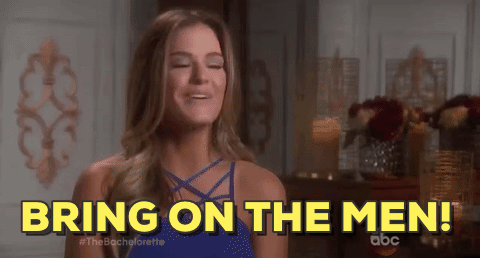Queering the Rose: Homosociality on ABC's The Bachelorette
We all have guilty pleasures. Many of them probably make us “bad feminists.” One of my own vices is my 7-year obsession with The Bachelor franchise. As a genre, reality TV doesn’t offer much feminist potential, but The Bachelor franchise in particular is possibly one of the most heteronormative, capitalist endeavors of contemporary television programming. The seasons alternate between women disparaging one another as they compete for the love of one man and men performing their masculinity as they vie for the attention of one woman.
Watching the show as a feminist is both frustrating and fascinating. Existing at the juncture of commodified romance, endorsed voyeurism, and extreme heteronormativity, the franchise seems irredeemably problematic. With a central focus on heterosexual romance, monogamy, and marriage, the show is distinctly heteronormative*. However, The Bachelorette in particular might demonstrate that extreme heteronormativity actually fosters queer/alternative/non-normative spaces. Confined to the mansion with no link to the outside world during filming, the contestants must live, eat, talk, and socialize with one another (referred to as homosociality). Tracking same-gender spaces on the show reveals one way in which the heteronormative structure of the show inherently cultivates homosociality and relationships between men.
On Season 11 of The Bachelorette, two men had a relationship that became ambiguous, verging on explicitly queer. The contestants, Clint and JJ, were on the show to fall in love with the bachelorette, Kaitlyn. Instead, Clint and JJ spent their time together - in the hot tub, on the couch, and even in the shower. According to Clint’s own confessional interviews, “the possibility of coming onto The Bachelorette and falling in love with a man never crossed my mind. But [...] at this point, I am a success story” (ABC Television Network). Labelled publicly as a bromance, Clint’s own language implies that something more than friendship occurred between him and JJ. Their ambiguous relationship distracted from the show’s narrative for a single episode arc where confessional interviews, hidden camera shots, and contrived scenes revealed a mutual affection that reads queer.
Later, the relationship was referred to as #BrokebackBachelor by the network itself. The shift from friendship to implied romance can be conceptualized as occurring on an “unbroken continuum” first introduced by queer theorist Eve Sedgwick in her seminal book, Between Men. Sedgwick argues that homosociality is inherently related to homoeroticism, or homosexual desire. By this logic, bromance, #BrokebackBachelor, and explicit homoerotic relationships are all connected points on the same spectrum.
In Between Men, Sedgwick also coins the term “erotic triangle” to refer to the circuits of desire that connect two men vying for one woman’s affection. Sedgwick reimagines this “triangle” to propose that “the bonds of ‘rivalry’ and ‘love’, differently as they are experienced, are equally powerful and in many sense equivalent” (21). Thus, in a heterosexual competition, homosocial desire is created. One can easily see the connection to The Bachelorette, where a group of men come together to compete for one woman. Clint and JJ, though not fictional, were positioned in an erotic triangle like Sedgwick describes, with Kaitlyn as the object of desire.
ABC’s embrace of Clint and JJ’s narrative arc complicates whether or not such a portrayal is radical and queer in the context of reality television. The confessional interview, the homosocial enclave, and the #BrokebackBachelor marketing all facilitated the disruption of heteronormativity for an episode. However, the simultaneous bromance labeling and the question of ABC’s profit, among other things, undermines the radicalness of Clint and JJ’s relationship. The importance of examining queerness on the Bachelorette is less related to Clint and JJ on an individual level, and has more to do with the unthreatened status of hegemonic heteronormativity in popular culture.
Clint and JJ’s relationship reveals the complex functions inherent to heteronormativity in popular culture, and thus is worthy of critical thought and scholarly attention. The possibility of queer interpretations embedded in heteronormative structures complicates the way we regard pop culture. While, by no means a replacement for positive representation, alternate receptions of mass culture open the door to a less normative world.
Citations
Sedgwick, Eve Kosofsky. Between Men : English Literature and Male Homosocial Desire. Gender and Culture. New York: Columbia University Press, 1985.
*terminology
heteronormative - where heterosexuality is just a sexual identity, heteronormativity is a system of power and privilege that devalues certain identities and behaviors. heteronormativity encompasses everything from assuming somebody is heterosexual until being told otherwise to buying into the consumer/domestic model of love that includes marriage, kids, house ownership, etc.





